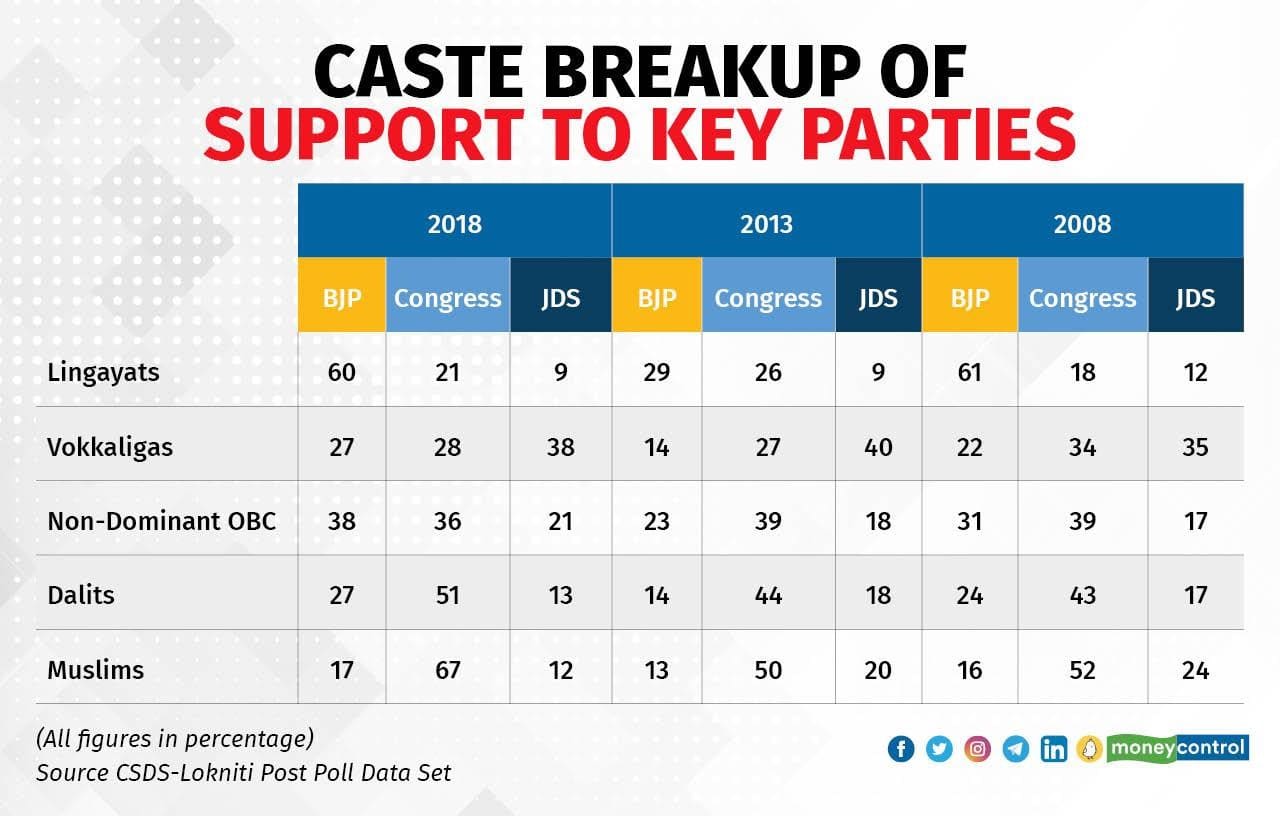



Social Arithmetic seems to be the buzzword in conversations on Karnataka’s electoral politics. Caste permutations and combinations are being animatedly discussed within party circles and in the media. While political parties and their leaders make the formal argument that they do not seek votes on caste lines, it is clear that caste identities are critical in both choice of candidates as well as analysing electoral prospects.
Both the BJP and the Congress are aiming at building broad rainbow coalitions across caste groups in order to bolster their chances of emerging with a clear majority in the coming elections.
Traditionally, Karnataka has had two dominant castes – the Lingayats and the Vokkaligas. The Lingayats have a strong presence in Northern Karnataka and the Vokkaligas are a key force in the Old Mysore region. Between them, the two castes account for more than half the MLAs elected to the state legislature since 1957.
Lingayats: BJP’s BedrockEver since the rise of the BJP in Karnataka politics, the Lokniti-CSDS data shows that it has enjoyed significant support among the Lingayats. This is evidenced in the data provided in Table 1. In 2013, with Yediyiurappa breaking away from the BJP, there was a clear split in the Lingayat vote. The consolidation of the Lingayat vote with the BJP was evident in the 2018 assembly elections.

The fact that a prominent Lingayat leader was the chief ministerial candidate of the BJP (Yediyurappa) helped galvanise this support. This time around, while Yediyurappa is a principal campaigner for the party, he is no longer the chief ministerial candidate. In fact, the Chief Minister, who belongs to the Lingayat community has not been projected as the chief ministerial candidate.
What will be keenly watched is whether the Lingayats continue to support the BJP with the same intensity as in the past. The internal dynamics within the Lingayat fold is an added dimension that complicates the caste equations.
Vokkaligas: Leaning All SidesThe Vokkaligas who dominate the Old Mysore heartland, have been split in their support for the three principal players. The JD(S) has invariably cornered a lion’s share of their vote but both the Congress and the BJP have strong pockets of support. The data from the CSDS-Lokniti post poll surveys, provide evidence of the above-mentioned trends.
It must be added that in the 2019 Lok Sabha elections, the BJP did well in the Old Mysore region and data from the CSDS-Lokniti post poll survey indicate that close to six of every ten Vokkaliga votes went to the BJP. In state assembly elections, the JD(S) has been a key option for the Vokkaligas and the efforts of both the BJP and the Congress to inch towards the majority mark is linked to the support it is able to garner among this second dominant caste.
The BJP is hoping to bank on the special provisions it has made for both the Lingayats and the Vokkaligas in the new reservation matrix.
OBCs and Dalits: With Congress?The non-dominant Backward Castes have been crucial in impacting electoral outcomes. Siddaramaiah’s AHINDA movement did galvanise the non-dominant OBCs in favour of the Congress in 2013. This is evident in the CSDS-Lokniti Post Poll Data Analysis. Last time around (2018), the BJP did increase its support among the non-dominant OBCs.
In 2023, the way this vote shapes us would again be critical in defining the electoral outcome. One disquiet of this segment is the separate space provided to the dominant castes within the backward caste quota in the latest reservation matrix announced by the state.
The Congress has largely benefitted from the Dalit vote. The “right” among the Dalits have consistently voted for the Congress while among the “left”, there were indications of a tilt towards the BJP. With the government enhancing the quota for Scheduled Castes, there is a little unhappiness among the “left” groups as their demands in the internal quota were not conceded. The internal quota was sought to ensure that the benefits of reservation are not monopolised by a few castes within the Scheduled Castes.
Limits To Majority ConsolidationThe Muslims account for close to 16 percent of the state population. CSDS-Lokniti data shows that the Muslims have been consistently supporting the Congress. The abolition of the 4 percent quota for Muslims and their being clubbed with the economically backwards, is a part of the new reservation matrix of the government.
This could well consolidate the minority vote further with the Congress. Is there a chance of a majority consolidation for the BJP? In the Karnataka context, it appears that such a consolidation has already peaked and there is little scope for it to expand further.
The caste arithmetic is not merely about creating a social coalition but also about the political chemistry that such an alliance requires. While many view it in simplistic terms as involving the adding together of caste support, the reality at the end of the day is the political chemistry that binds together the caste arithmetic. Which rainbow coalition would sustain this political chemistry would clearly have an edge in the race to power.
Discover the latest Business News, Sensex, and Nifty updates. Obtain Personal Finance insights, tax queries, and expert opinions on Moneycontrol or download the Moneycontrol App to stay updated!
Find the best of Al News in one place, specially curated for you every weekend.
Stay on top of the latest tech trends and biggest startup news.